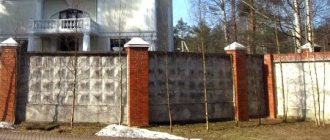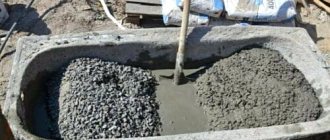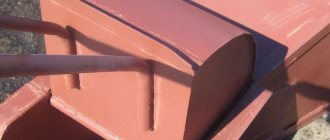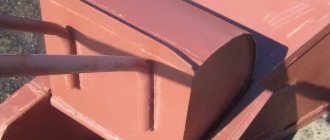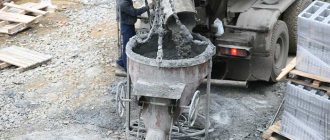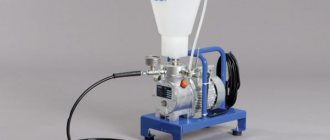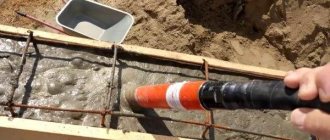When operating concrete and brick structures, sooner or later the need arises for major construction and restoration work of both the foundation and above-ground parts. This is a labor-intensive and expensive process. However, today there is a new and effective technology for the reconstruction of buildings and other types of structures - concrete injection or injection.
This technique involves filling cracks on various surfaces using special polymer compounds that are applied under very high pressure. Such concrete injections make it possible to most effectively seal cracks and other defects on surfaces.
When is injection performed?
Concrete injection is often used for waterproofing basements or tunnels. This is especially true when leaks form in surfaces.
In addition, the injection type of work is suitable for sealing cracks in walls, ceilings and floor screeds. This method is also relevant when restoring the foundation if “cold seams” were made during its construction. It is worth considering that quite often debris remains between adjacent parts of the base, which subsequently has a negative impact on the adhesion properties and water resistance of the building.
Also, such a procedure makes it possible to enhance the waterproofing properties of foundations made of blocks. In this case, the injection composition fills even the smallest cracks and voids in a reinforced concrete or concrete monolith.
In addition, a similar procedure is performed to strengthen piles when repairing foundations.
Also, crack injection is performed when the seams are deformed. This usually happens with foundations for parking lots or underground passages.
Concrete injection has become quite widely used due to the numerous advantages of this procedure:
- the ability to instantly waterproof and seal;
- maintaining the integrity of the structure, without disturbing the design of the building;
- the possibility of restoring even the most inaccessible areas of the structure;
- no need to carry out earthworks;
- possibility of performing work all year round.
However, it is worth considering that the quality of the work performed directly depends on the material chosen for injecting cracks in concrete.
Features of the technology
Injection is a modern method of restoring the strength of a concrete or stone structure, strengthening brickwork, as well as a method of waterproofing joints. The injection technique is based on the penetration of a special solution into all voids - into crevices, cracks, pores and holes. The composition is introduced under strong pressure using special devices.
Hydrophobic material is pumped into the object being insulated or placed between the surface and the outer layer. This helps create a waterproof membrane between the environment and the structure. Also, the insulating layer will act as a protective frame, reliably strengthening the building.
The advantages of injection over major repairs with complete dismantling are obvious:
- the ability to reduce the cost of restoring a building;
- the ability of solutions to seal even large cracks and areas of delamination of structures;
- creation of a monolithic layer without seams or joints;
- strengthening the strength of walls and foundations;
- eliminating emergency leaks;
- safety for humans when solutions come into contact with drinking water.
The downside is that injection equipment is expensive, but it can be rented. It is impossible to carry out work without proper experience; this can provoke even greater destruction of buildings. The process should only be entrusted to professionals.
If the reinforcement is free of rust and the damage is moderate, then the base injection method is carried out in a standard manner. When the damage is more serious, the damaged areas are removed and sealed with special mixtures.
Compositions for injection
Mixtures for injecting cracks in brickwork or concrete are subject to special requirements, according to which the compositions must differ:
- reduced viscosity;
- high levels of penetrating ability (this means that the composition must fill even the most microscopic cracks);
- high adhesion (adhere well to various building materials);
- corrosion resistance;
- minimal shrinkage after complete hardening of the mixture;
- long service life.
All these requirements are met by three types of compounds: epoxy or polyurethane resins, polycement materials (microcements) and specialized waterproofing solutions.
Resins
Injection of walls and other bases using resins is carried out if the thickness of the crack is no more than 0.5 mm. This material is able to quickly fill microscopic pores, due to which the load-bearing capacity and strength of concrete are completely restored after reconstruction.
There are two types of resins:
Polyurethane
In addition to filling cracks, this resin also allows for additional waterproofing. Most often, injection of cracks using polyurethane compounds is performed when processing wet joints, as well as for the reconstruction of concrete and reinforced concrete monolithic structures. In addition, resins of this type are used to stop the flow of water (gravity or pressure) and in the process of waterproofing communications.
If we talk about the composition of polyurethane resin, then it includes: component A (base) and component B (hardener). The resin acquires its properties only when they are mixed until smooth. In this case, mixing can be done either preliminarily or directly in the injection pump head.
Epoxy
Resins of this type are characterized by increased chemical resistance and set fairly quickly, forming a durable material. Most often, epoxy compounds are injected into dry cracks or seams. In this case, the load-bearing capacity of the structure is completely restored. If the epoxy comes into contact with water, its volume can increase 2-3 times, resulting in the formation of a waterproofing layer.
Another advantage of epoxy resins is the absence of solvents and good adhesion to a wide variety of materials.
Types of structures
Waterproofing by injection is a universal method with a wide range of applications. Most often it is used on old objects made of brick, concrete, stone. Here are the main purposes of the technology:
- filling cracks, voids, capillaries inside buildings and structures (including defects formed during violation of construction techniques);
- insulation of cold joints on concrete and reinforced concrete structures;
- repair of expansion joints;
- installation of internal waterproofing to remove capillary suction;
- insulation of grounded objects.
Injection is used for complex structures - swimming pools, parking lots, sewers, subways, but is no less often used for residential buildings and their individual parts.
Foundations and basements
Foundation repairs are carried out using cement, cement-sand mortar. Also suitable for this purpose are compositions based on siloxanes and silicates. Thanks to this technique, the insulating properties of the foundation are enhanced and it will be protected from the negative effects of external factors. This mainly concerns destruction from temperature changes and the action of groundwater.
The selected composition is pumped under pressure into damaged areas of the foundation so that it penetrates even the smallest pores and cracks. Next, the finished object is carefully checked by engineers: water flows should no longer have a destructive effect on the material.
Injection of basements is carried out in a similar way. The work allows for vertical isolation and horizontal cutting off of soil, which will protect the structure from the penetration of capillary moisture. In this way, you can restore the room without digging in and dismantling old masonry.
Cracks and seams in concrete
Concrete injection is used more often than repairing other building materials. The technique helps to waterproof cold and moving joints and prevent cracks from enlarging. After sealing, water will no longer penetrate through the defects. If the quality of the concrete is satisfactory, such manipulations are sufficient to seriously strengthen it. But if the material is in poor condition or the reinforcement is severely corroded, part of the structure has to be removed, after which it is restored with cement or epoxy resin.
For optimal repair of cracks and seams in concrete, it is important to choose the right injection composition. The best choice is microcement, which has the required viscosity, has almost no shrinkage, and can be worked with at any ambient temperature.
Brickwork and walls
Injection of buildings and individual structures made of brick increases the quality of construction several times, creates complete waterproofness, but does not change the normal vapor permeability. The technique also greatly increases the reliability of the brick and makes it resistant to damaging factors. The injection method of repair does not require large expenses, which inevitably arise when dismantling old masonry and erecting new one.
When it comes to bricks, work is most often carried out using microcement. It helps create an anti-filtration curtain. This is achieved by pumping solutions from the inside of the building. There is also a method of strengthening the structure from the outside, which is less expensive.
Polycement materials
It is recommended to use such compositions if the damage is more significant. Polycement materials or microcement are Portland cements that have been developed for injection. These compositions are distinguished by a special degree of grinding, due to which they penetrate well into all formed cavities, pores and crevices.
Also, such materials may contain additional components. For example, Runit injection mortar for masonry contains white portlant cement with carbonate-quartz filler, lime and additional additives. Thanks to this, it becomes possible to control the hardening time of the composition, as a result of which there is no need to pause during the work process.
Most often, microcement is used to strengthen old buildings with reinforced concrete columns. This procedure is called strengthening foundations with drilled injection piles. To accomplish this, special concrete structures are installed into the ground at an angle of up to 45 degrees. To do this, wells are first drilled, which are subsequently filled with microcement, which is injected under high pressure.
This material is also used when shrinkage cracks appear and to stop water flows.
Types of cracks
To know how to repair cracks in concrete, you must first determine what type it belongs to:
- Through cracks occur due to tensile forces;
- Surface cracks appear after the concrete has dried due to a violation of the mortar formulation;
- Cracks in the tension zone appear during bending and are directed transversely to the reinforcing bars;
- Cracks located at an angle to the reinforcement, which occur under the influence of shear force;
- Shrinkage cracks parallel to the reinforcement, which arise due to soil heaving, uneven shrinkage or improper anchoring. Due to such cracks, shrinkage and deformation of the foundation and the entire building occurs. Shrinkage cracks can also appear if the load calculation was not made according to the rules of SNiP;
- Small cracks that appear due to temperature changes;
- Hairline cracks occur for the same reason as the previous ones, but usually their depth does not exceed a few millimeters.
Having determined the causes and types of cracks, the type of repair work is determined.
Waterproofing compounds
Waterproofing by injection is most often performed using polyurethane, which perfectly resists moisture penetration. It is used for processing seams and joints between monolithic elements, for the restoration of wet areas and for sealing holes and cracks in sewer and water supply networks.
Acrylic gels are also used for waterproofing, which are characterized by low viscosity and the ability to increase in volume in a humid environment. Due to the good fluidity of such compositions, they quickly create waterproof barriers. In addition, gels not only fill cracks, but also dry out the space around them.
Any of the compositions described above is injected into a concrete monolith using specialized tools.
How to repair defects in concrete
When starting to repair cracks, first determine how you will do it. In most cases, thin cracks in concrete are simply primed, plastered, or painted on top.
Sealing of cracks is carried out mainly by filling the depth with synthetic mixtures with the addition of resins, which have low viscosity. Holes are drilled along the crack; they must be placed diagonally, towards the defect. After this, bushings are placed in the holes and the working mixture is pumped through them. Then the resin is pressed in using an injector. This method helps ensure that the structure has good strength and is able to function as a single unit.
Equipment used and its cost
If we talk about equipment for concrete injection, then the following are usually used for this purpose:
- Injection pumps. Their cost depends on the composition used. For example, a KSG-700 pump for cement mortars will cost about 82,000 rubles. For polyurethane and epoxy resins, the KSG 900 model, costing 48,000 rubles, is suitable. Also, you can find manual injection pumps on sale at a lower cost.
- Packers for injection. These elements are special tubes through which the solution is supplied to the concrete base. Now 1 injection packer costs about 50 rubles (however, it all depends on its size).
The cost of resin is about 800 rubles per 1 kg, acrylic gel will cost about 600 rubles. You will also need to buy protective tape, costing about 400 rubles per roll.
After purchasing everything you need, all that remains is to inject.
Execution of work
When injecting, everything depends on the type of damage. If a crack appears in a concrete monolith, the procedure is performed as follows:
- The crack is widened using a grinder.
- Parkers are inserted into the hole.
- Protective tape is glued to both sides of the crack.
- The crack and the tubes installed in it are filled with mortar, after which the injection composition is supplied through the holes into the concrete thickness.
- Parkers are removed and the surface is cleaned.
If we are talking about sealing injections on wet areas of the surface, the procedure will be as follows:
- Holes are drilled on the sides of the crack (in a checkerboard pattern) from which dust and concrete particles are removed using a vacuum cleaner.
- Parkers are installed into the holes and the compound is injected.
- The tubes are removed and the surface is covered with mortar.
When sealing pressure leaks, injection work is performed in exactly the same way, only in this case it is necessary to use special compounds that quickly harden and expand well.
Self-expanding cords
This method is used to carry out repair work in the bowls of outdoor swimming pools, to restore monolithic foundations and restore the integrity of external walls in industrial premises.
To carry out the work, you will need to prepare the area by clearing it of small fractions and dust, measure the depth and width of the crack and select a suitable self-expanding cord or tape.
A cord is placed into the pre-prepared seam and the remaining space is filled with polyurethane sealant from a mounting gun. Excess sealant is leveled with a spatula, and after the material has risen, the surface of the problem area is sanded.
This method of eliminating defects in concrete surfaces allows you to select a cord to seal any crack, which ensures complete sealing of the seam and a long service life. An important feature of the method is the ability to perform work at subzero temperatures.
